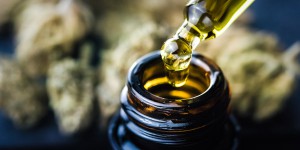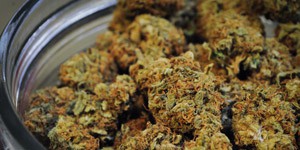By Viola Brugnatelli

Viola Brugnatelli is a neuroscientist and endocannabinologist, she carries out research and teaching on cannabis at the Dept. Of Neuroscience, University of Padua, Italy, and is the co-founder of
Cannabiscienza, an education company for healthcare professionals on the endocannabinoid system and medical cannabis.
A long standing member of the International Cannabinoid Research Society, and Italian Ambassador for the International Association for Cannabis Medicine, Viola's background is in pharmacology labs, specialising in orphan cannabinoid/terpenoid receptors and their signalling in pain and inflammation.
Currently she collaborates with Fundación Canna, the Journal of Cannabinoid Medicine editorial board, and as a guest author for a series of magazines in the field, including Project CBD. Viola
over the years contributed to several CME courses on cannabis, educating MDs and pharmacists worldwide. She is the VP of a non-for-profit that aims to empower women working with plant medicine.
What fascinates her most about the cannabis plant is what we can learn and understand about the endocannabinoid system and how to modulate it in different ways beyond phytocannabinoids. Lately she has been closely working with anaesthesiologists who operate with hypnotherapy to
evaluate the role of the ECS in the ability of altering our states of consciousness without drugs.
Could popular products for oral care such as Colgate or Oral B be replaced by cannabis-based formulations?
Not only this route seems possible, but the opposite may also be true. In fact, in April 2021 Colgate-Palmolive publicly announced the successful filing of three international patents for different oral care compositions utilising antibacterial cannabidiol (CBD), and incorporating a range of other non-narcotic cannabinoids, such as cannabigerol (CBG), cannabichromene (CBC) and cannabicitran (CBTC) to make different blends for mouthwashes, toothpaste, oral gels and more.
In the statement of Colgate-Palmolive, which earlier this same year acquired Hello Products, a famous natural cosmetic company which offers a range of CBD and hemp seed oil -containing oral care products : "the cannabinoid blends had been developed to improve oral health in several ways: reduce or inhibit formation of dental caries; reduce plaque accumulation and reduce gingival inflammation".
Since mouthwashes and toothpaste are classified as cosmetics, claims are not required to be supported by clinical evidence. With scientific literature indicating that chronic cannabis consumers have an increased risk for periodontal lesions, xerostomia (dry mouth), and caries, one is left to wonder whether there is any science supporting the cannabinoid-based oral care product trend.
First, let's address inflammation: evidence showed that CB2 receptors are found in periodontal tissue at sites of inflammation/infection, and compounds that activate CB2R may regulate inflammation and help improve current treatments for periodontitis and other oral inflammatory pathologies.
Adding to this, both CB1 and CB2 receptors are expressed in gingival tissue, and their expression increases greatly during diseased conditions. This is because once activated by endogenous cannabinoids like Anandamide, CB1 and CB2 trigger a significant reduction in the production of pro-inflammatory mediators at those sites, thus suggesting that phytocannabinoids with similar pharmacological activity may regulate periodontal healing.
A literature review evaluating oral mucositis, (a painful inflammation and ulceration of the mouth, which is a common, and often debilitating complication of cancer treatment) and the mechanisms of action of CBD, concluded that the anti-inflammatory, analgesic and antioxidant properties of CBD may be beneficial for patients suffering with this condition, albeit yet to be tested.
So, as we understand better how the endocannabinoid system regulates oral inflammation, we also came to understand that endocannabinoid tone modulates inflammation-induced decreased salivation at the salivary glands; this seems to match the difference found in salivation between tobacco and cannabis smokers, with dry mouth experienced by 69.6% of the cannabis group, compared to 18.6% of the cigarette smoking group.
Considering that xerostomia is related to gingival disease through the accumulation of dental plaque, it is interesting to examine whether CBD may actually be a good option for dental plaque.
On this topic previous evidence showed that CBD and another non-narcotic cannabinoid, cannabigerol (CBG), are known to have antibacterial activity against several gram-positive as well as gram-negative bacterial species and more recent studies have shown that both these cannabinoids might play a role in dental plaque; in Belgium 60 adults were tested to compare the efficacy of different oral-care products at reducing dental plaque: those containing cannabinoids were found more effective in reducing the bacterial colony count in dental plaques as compared to the formulas of well-established synthetic oral care products, namely, Oral B and Colgate.
The same group later evaluated in a follow-up study, the efficiency of CBD-CBG products (that did not contain alcohol or fluoride) vs other commonly available commercial mouthwash products vs the dentist gold standard chlorhexidine (a disinfectant and antiseptic which was found to be carcinogenic).
This research was conducted examining samples deriving from 72 participants. The results showed that mouthwashes containing CBD and CBG at <1% were as effective as 0.2% chlorhexidine mouthwashes in reducing dental plaque.
What the patents of Colgate-Palmolive did not claim was that their oral-care line could decrease mouth pain or induce muscle relaxant effects, despite those being some of the most historical medicinal uses of cannabis in dentistry. It is known that ancient Arabian physicians and other populations used to induce sedation and a sort of general inhalational anesthesia by the so-called Aleppo sponge, dipped in a mixture of cannabis, opium and other compounds, and then positioned over the nose of the patient that needed tooth extraction or similar surgeries.
Recently in Poland it has been recently tested CBD for temporomandibular pain (TMD), a condition that affects 20 to 30% of the adult population, being the second most frequent cause of orofacial pain after toothache.
For this research 60 patients with TMD were selected and divided into two groups: the experimental group and the control group. The treatment group was assigned to a transdermal patch containing a 20% CBD-based ointment in Olive Oil. The second group was only given the patch, without CBD (placebo patch). Both groups used a new patch in the morning and one in the night; Both groups underwent a first follow-up visit and a second one after 14 days of patch application. The intensity of pain perceived was addressed through a standardised questionnaire (the so-called visual analog scale, VAS) and the muscle tension were assessed, through the application of electrodes in the mandibular area. In the case of the CBD group, after 14 days a significant effect on the masseter muscles was highlighted (11% reduction in the right masseter muscle and 12.6% in the left); in the case of the control group there was no reduction in muscle activity. Even the intensity of pain, according to the VAS scale, was significantly reduced in the CBD-patch group: 70.2% compared to the placebo-patch group, in which a reduction of only 9.81% was recorded.
This study shows that CBD may be effective in reducing temporomandibular pain and should be considered in the therapy of chewing muscles in patients with temporomandibular pain.
So... phytocannabinoids and oral-care products, a fad or here to stay?
One may think whether we are just tapping their potential applications as much more research it is being conducted to establish the potential use of cannabis compounds in dental care.
References:
Ammaar H Abidi, Sahar S Alghamdi, Mustafa Kh Dabbous, David A Tipton, Suni M Mustafa, Bob M Moore J Periodontal Res actions 2020 Oct;55(5):762-783. doi: 10.1111/jre.12765. Epub 2020 Jun 20. Cannabinoid type-2 receptor agonist, inverse agonist, and anandamide regulation of inflammatory responses in IL-1β stimulated primary human periodontal ligament fibroblasts
Appendino G, Gibbons S, Giana A, Pagani A, Grassi G, Stavri M, et al. Antibacterial cannabinoids from Cannabis sativa: a structure-activity study. J Nat Prod. 2008;71(8):1427–30. https://doi.org/10.1021/np8002673.
Cho C M, Hirsch R, Johnstone S. General and oral health implications of cannabis use. Aust Dent J 2005; 50: 70-74.
Cuba, Letícia de Freitas, et al. "Cannabidiol: An Alternative Therapeutic Agent for Oral Mucositis?" Journal of Clinical Pharmacy and Therapeutics, vol. 42, no. 3, June 2017, pp 245-250.
Cureus. 2020 Jan 29;12(1):e6809. doi: 10.7759/cureus.6809.Comparison of Efficacy of Cannabinoids versus Commercial Oral Care Products in Reducing Bacterial Content from Dental Plaque: A Preliminary Observation
Darling M R, Arendorf T M. Effects of cannabis smoking on oral soft tissues. Community Dent Oral Epidemiol 1993; 21: 78-81.
Facco E, Zanette G. The Odyssey of Dental Anxiety: From Prehistory to the Present. A Narrative Review. Front Psychol. 2017 Jul 11;8:1155. doi: 10.3389/fpsyg.2017.01155. PMID: 28744243; PMCID: PMC5504153.
Fernandez-Solari J, Prestifilippo JP, Ossola CA, Rettori V, Elverdin JC. Participation of the endocannabinoid system in lipopolysaccharide-induced inhibition of salivary secretion. Arch Oral Biol. 2010 Aug;55(8):583-90. doi: 10.1016/j.archoralbio.2010.05.006. Epub 2010 Jun 9. PMID: 20542488.
Jäger A, Setiawan M, Beins E, Schmidt-Wolf I, Konermann A. Analogous modulation of inflammatory responses by the endocannabinoid system in periodontal ligament cells and microglia. Head Face Med. 2020 Nov 16;16(1):26. doi: 10.1186/s13005-020-00244-0. PMID: 33190638; PMCID: PMC7667774.
Kozono S, Matsuyama T, Biwasa KK, Kawahara K, Nakajima Y, Yoshimoto T, Yonamine Y, Kadomatsu H, Tancharoen S, Hashiguchi T, Noguchi K, Maruyama I. Involvement of the endocannabinoid system in periodontal healing. Biochem Biophys Res Commun. 2010 Apr 16;394(4):928-33. doi: 10.1016/j.bbrc.2010.03.080. Epub 2010 Mar 15. PMID: 20233580.
Mattes RD, Shaw LM, Engelman K. Effects of cannabinoids (marijuana) on taste intensity and hedonic ratings and salivary flow of adults. Chem Senses 1994;19:125–40. (https://doi.org/10.1016/j.adaj.2016.10.009)
Nakajima Y, Furuichi Y, Biswas KK, Hashiguchi T, Kawahara K, Yamaji K, Uchimura T, Izumi Y, Maruyama I. Endocannabinoid, anandamide in gingival tissue regulates the periodontal inflammation through NF-kappaB pathway inhibition. FEBS Lett. 2006 Jan 23;580(2):613-9. doi: 10.1016/j.febslet.2005.12.079. Epub 2006 Jan 3. Erratum in: FEBS Lett. 2006 Mar 20;580(7):1909. PMID: 16406050.
Nitecka-Buchta A, Nowak-Wachol A, Wachol K, Walczyńska-Dragon K, Olczyk P, Batoryna O, Kempa W, Baron S. Myorelaxant Effect of Transdermal Cannabidiol Application in Patients with TMD: A Randomized, Double-Blind Trial. J Clin Med. 2019 Nov 6;8(11). pii: E1886
Özdemir B, Shi B, Bantleon HP, Moritz A, Rausch-Fan X, Andrukhov O. Endocannabinoids and inflammatory response in periodontal ligament cells. PLoS One. 2014 Sep 16;9(9):e107407. doi: 10.1371/journal.pone.0107407. eCollection 2014.)
Prestifilippo JP, Fernández-Solari J, Medina V, Rettori V, Elverdin JC. Role of the endocannabinoid system in ethanol-induced inhibition of salivary secretion. Alcohol Alcohol. 2009 Sep-Oct;44(5):443-8. doi: 10.1093/alcalc/agp040. Epub 2009 Jul 9. PMID: 19589828.
Prestifilippo JP, Medina VA, Mohn CE, Rodriguez PA, Elverdin JC, Fernandez-Solari J. Endocannabinoids mediate hyposalivation induced by inflammogens in the submandibular glands and hypothalamus. Arch Oral Biol. 2013 Sep;58(9):1251-9. doi: 10.1016/j.archoralbio.2013.04.003. Epub 2013 May 15. PMID: 23684250.
Thavarajah R, Rao A, Raman U, Rajasekaran S T, Joshua E R H, Kannan R. Oral lesions of 500 habitual psychoactive substance users in Chennai, India. Arch Oral Biol 2006; 51: 512-519.
Vasudevan, K., Stahl, V. Cannabinoids infused mouthwash products are as effective as chlorhexidine on inhibition of total-culturable bacterial content in dental plaque samples. J Cannabis Res 2, 20 (2020).


